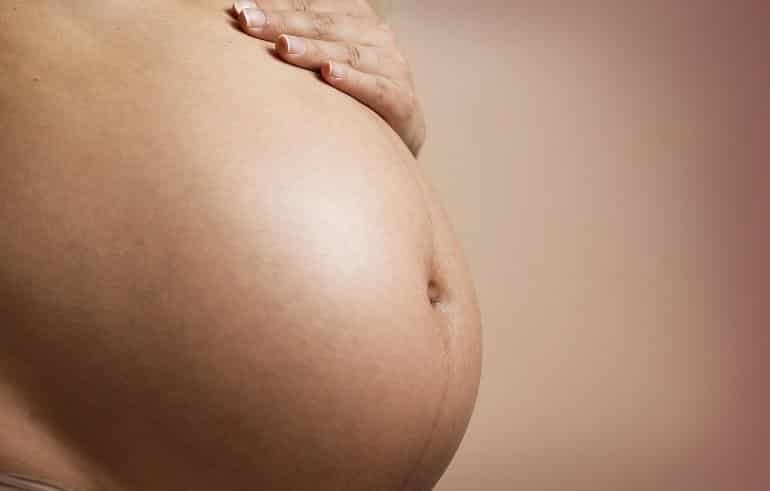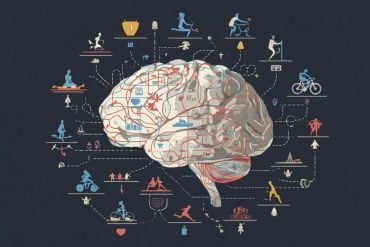Summary: Bipedalism dramatically reshaped the hominin pelvis into a real birth canal. Researchers report Australopithecus had complex birth patterns compared to Great Apes and were likely to have practiced co-operative breeding.
Source: University of Zurich
During human birth, the fetus typically navigates a tight, convoluted birth canal by flexing and rotating its head at various stages. This complex process comes with a high risk of birth complications, from prolonged labor to stillbirth or maternal death.
These complications were long believed to be the result of a conflict between humans adapting to walking upright and our larger brains.
Dilemma between walking upright and larger brains
Bipedalism developed around seven million years ago and dramatically reshaped the hominin pelvis into a real birth canal. Larger brains, however, didn’t start to develop until two million years ago, when the earliest species of the genus Homo emerged.
The evolutionary solution to the dilemma brought about by these two conflicting evolutionary forces was to give birth to neurologically immature and helpless newborns with relatively small brains – a condition known as secondary altriciality.
A research group led by Martin Häusler from the Institute of Evolutionary Medicine at the University of Zurich (UZH) and a team headed up by Pierre Frémondière from Aix-Marseille University have now found that australopithecines, who lived about four to two million years ago, had a complex birth pattern compared to great apes.
“Because australopithecines such as Lucy had relatively small brain sizes but already displayed morphological adaptations to bipedalism, they are ideal to investigate the effects of these two conflicting evolutionary forces,” Häusler says.
Typical ratio of fetal and adult head size
The researchers used three-dimensional computer simulations to develop their findings. Since no fossils of newborn australopithecines are known to exist, they simulated the birth process using different fetal head sizes to take into account the possible range of estimates. Every species has a typical ratio between the brain sizes of its newborns and adults.
Based on the ratio of non-human primates and the average brain size of an adult Australopithecus, the researchers calculated a mean neonatal brain size of 180 g. This would correspond to a size of 110 g in humans.
For their 3D simulations, the researchers also took into account the increased pelvic joint mobility during pregnancy and determined a realistic soft tissue thickness. They found that only the 110 g fetal head sizes passed through the pelvic inlet and midplane without difficulty, unlike the 180 g and 145 g sizes.

“This means that Australopithecus newborns were neurologically immature and dependent on help, similar to human babies today,” Häusler explains.
Prolonged learning key for cognitive and cultural abilities
The findings indicate that australopithecines are likely to have practiced a form of cooperative breeding, even before the genus Homo appeared. Compared to great apes, the brains developed for longer outside the uterus, enabling infants to learn from other members of the group.
“This prolonged period of learning is generally considered crucial for the cognitive and cultural development of humans,” Häusler says.
This conclusion is also supported by the earliest documented stone tools, which date back to 3.3 million years ago – long before the genus Homo appeared.
About this evolutionary neuroscience research news
Author: Melanie Nyfeler
Source: University of Zurich
Contact: Melanie Nyfeler – University of Zurich
Image: The image is in the public domain
Original Research: Closed access.
“Dynamic finite-element simulations reveal early origin of complex human birth pattern” by Pierre Frémondière et al. Communications Biology
Abstract
Dynamic finite-element simulations reveal early origin of complex human birth pattern
Human infants are born neurologically immature, potentially owing to conflicting selection pressures between bipedal locomotion and encephalization as suggested by the obstetrical dilemma hypothesis.
Australopithecines are ideal for investigating this trade-off, having a bipedally adapted pelvis, yet relatively small brains. Our finite-element birth simulations indicate that rotational birth cannot be inferred from bony morphology alone.
Based on a range of pelvic reconstructions and fetal head sizes, our simulations further imply that australopithecines, like humans, gave birth to immature, secondary altricial newborns with head sizes smaller than those predicted for non-human primates of the same body size especially when soft tissue thickness is adequately approximated.
We conclude that australopithecines required cooperative breeding to care for their secondary altricial infants.
These prerequisites for advanced cognitive development therefore seem to have been corollary to skeletal adaptations for bipedal locomotion that preceded the appearance of the genus Homo and the increase in encephalization.






